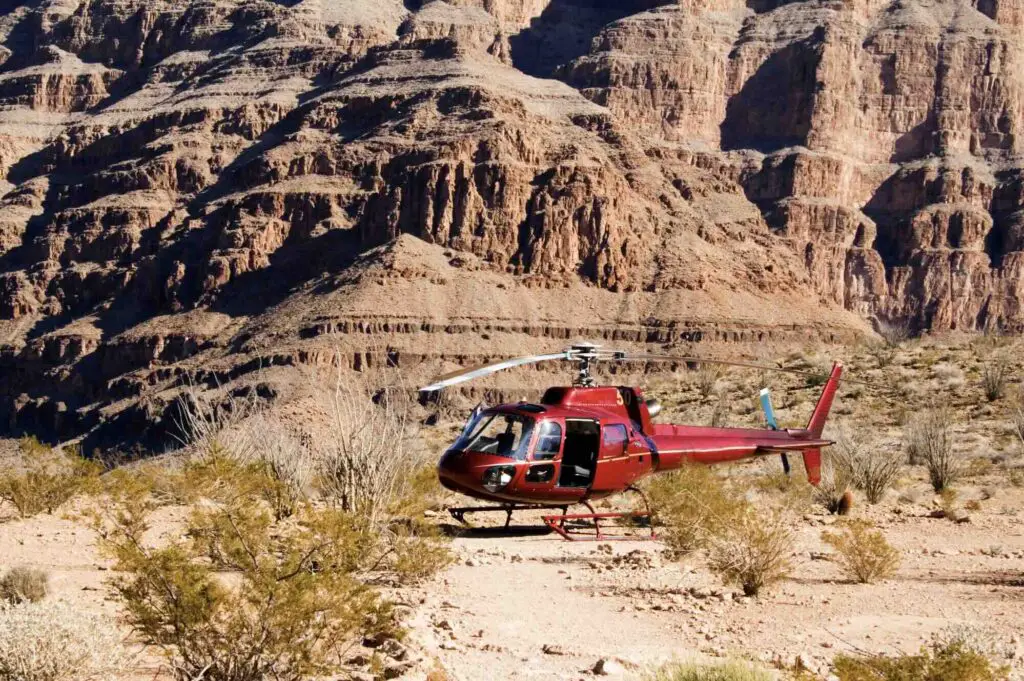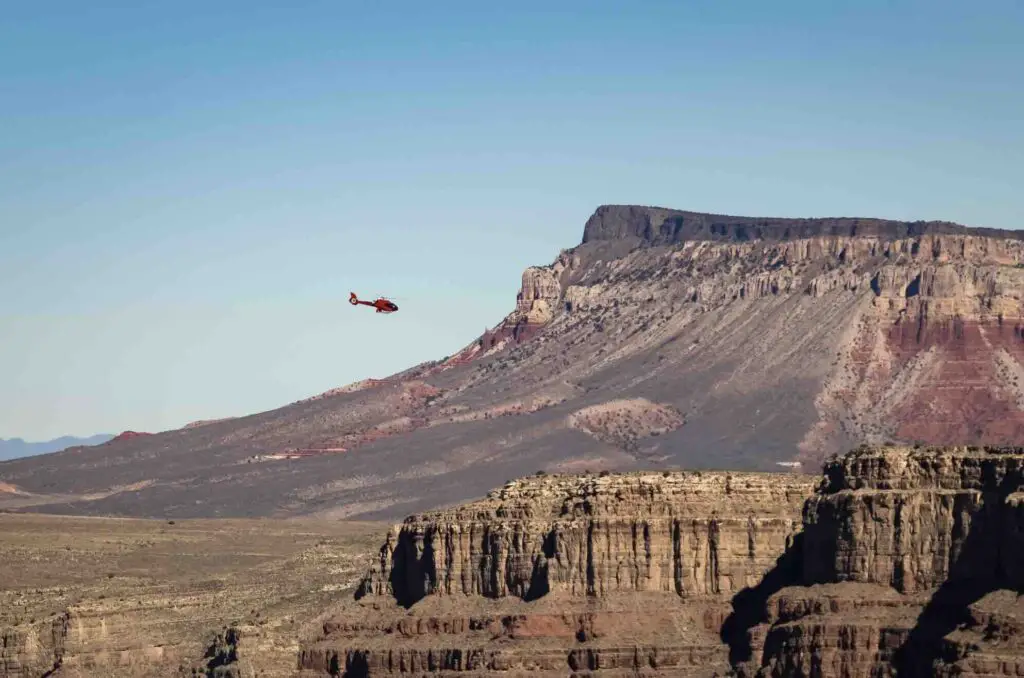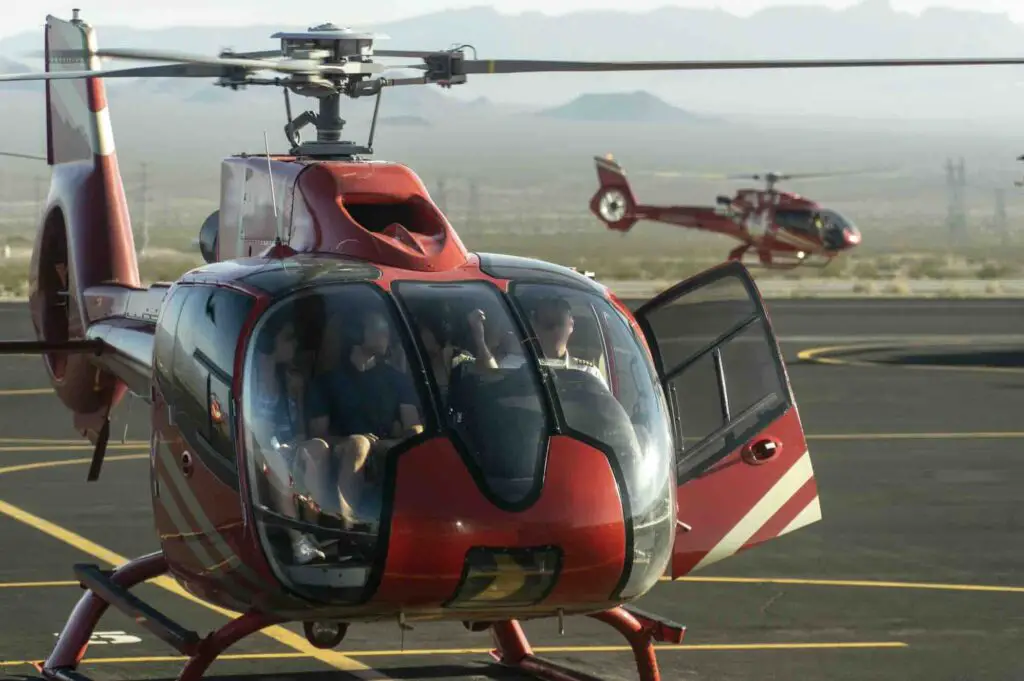The Grand Canyon, one of the world’s most awe-inspiring natural wonders, captivates the hearts and minds of millions each year. Many people want to see the Grand Canyon by air or with a Helicopter ride.
The Grand Canyon’s vastness, intricate rock formations, and sheer beauty make it a bucket-list destination for travelers from all corners of the globe. For those pressed for time or seeking a unique vantage point, taking to the skies in a helicopter offers an unforgettable perspective of this geological masterpiece. Read on as we explore the safety of helicopter rides over the Grand Canyon.
Table of Contents
- Grand Canyon History: Helicopter Crashes And Safety Concerns
- Ensuring A Safe Helicopter Ride Over The Grand Canyon – 8 Points To Consider
- Related Questions
Grand Canyon History: Helicopter Crashes And Safety Concerns
With its breathtaking vistas and geological marvels, the Grand Canyon is a magnet for travelers worldwide. Many opt for a bird’s-eye view, taking to the skies in helicopters or fixed-wing airplanes.

While this aerial perspective offers unparalleled views and experiences, it’s also been shadowed by safety concerns and a history of unfortunate incidents.
A Skyward Surge: The Popularity Of Aerial Tours
Each year, an estimated 800,000 people soar above the Grand Canyon, marveling at its vastness and intricate tapestry of rock formations from the air. This aerial perspective offers a unique vantage point, allowing visitors to grasp the canyon’s accurate scale and beauty.
The allure of such an experience has led to a burgeoning aerial tourism industry around the canyon.
Tragedy In The Skies: A Look At The Past 15 Years
Despite the exhilarating experience, the past decade and a half have witnessed tragic moments. During this period, nearly 50 souls have been lost in aerial accidents over the Grand Canyon. Each of these incidents is a stark reminder of the inherent risks associated with aviation, even in an age of technological advancements and strict safety protocols.
To put this into perspective, considering 800,000 aerial visitors annually, we’ve seen 12,000,000 travelers in the past 15 years. Out of this vast number, 50 fatalities amount to a rate of just 0.000416 percent or roughly 0.049 deaths per 100,000 travelers.
Though any loss of life is tragic, flying by helicopter over the Grand Canyon is a relatively safe way to see the Grand Canyon by air.
Relative Safety: Crunching The Numbers
When we delve into the data, the statistics reveal that helicopter tours over the Grand Canyon are relatively safe. With a fatality rate of 0.049 per 100,000 travelers, the risk is minuscule. To further illustrate this point, various everyday activities, including driving, come with their risks, often far surpassing the risks associated with Grand Canyon helicopter tours.
That said, losing even a single life is tragic, even with a low fatality rate. And while the percentage might seem insignificant, the pain and loss are immeasurable for the families and friends of the 50 individuals who lost their lives.

Safety Protocols And Continued Vigilance
Understanding stringent safety regulations governing aerial tour operators around the Grand Canyon is essential. Helicopters and planes undergo regular maintenance checks, pilots receive rigorous training, and safety protocols are continually updated based on new findings and technological advancements.
Moreover, following each unfortunate incident, investigations are carried out to pinpoint the cause, ensuring that lessons are learned and measures are implemented to prevent similar occurrences.
Helicopter Ride Over The Grand Canyon Is A Safe Experience With Due Caution
Flying over the Grand Canyon in a helicopter or airplane offers a unique and mesmerizing experience, and the statistics confirm that it’s generally a very safe adventure. However, like all activities, it doesn’t come without risks.
As travelers, it’s crucial to be informed, choose reputable tour operators, and know the safety protocols.
Ultimately, while the chances of a tragic event are statistically low, it’s a solemn reminder of the unpredictability of life. In all its majestic glory, the Grand Canyon is a testament to the passage of time and the ever-present dance between risk and wonder in our lives.

Ensuring A Safe Helicopter Ride Over The Grand Canyon – 8 Points To Consider
Flying over the Grand Canyon offers an unparalleled vantage point, allowing travelers to grasp its vastness and beauty fully. To ensure this experience is not just memorable but also safe, here are eight crucial tips to keep in mind:

1. Scrutinize The Safety Record:
Before booking, take the time to research the safety record of the helicopter company you’re considering. Past performance often indicates the company’s commitment to safety. A company with a clean or nearly spotless record is always a good sign.
2. Opt For Favorable Weather:
The weather can significantly impact the safety and quality of your flight. It’s always best to fly in clear and calm conditions. If the weather looks unfavorable, consider rescheduling your trip.
3. Choose A Reputable Company:
Popularity isn’t always an indicator of quality. Go for companies known for their professionalism, well-maintained aircraft, and experienced pilots.
4. Ask About Pilot Experience:
The pilot’s expertise plays a significant role in the safety of the flight. Ensure the pilot has substantial experience, especially flying over the Grand Canyon, which presents challenges.
5. Wear And Understand Appropriate Safety Gear:
Most reputable companies will provide safety gear and training. Wear them correctly and listen to safety briefings or demonstrations before the flight.
6. Avoid Overloading:
Helicopters have weight limits for a reason. Ensure that you and your belongings, combined with other passengers and their belongings, don’t exceed the aircraft’s weight limit.
7. Communicate Any Concerns:
If you have any doubts or concerns before or during the flight, communicate them to the staff or pilot. It’s essential to feel comfortable and safe throughout your journey.
8. Familiarize Yourself With Emergency Protocols:
While the chances of an emergency are minimal, it’s always good to be prepared. Familiarize yourself with the helicopter’s safety features and emergency exit procedures.
By following these guidelines, travelers can significantly enhance the safety of their aerial tour. The Grand Canyon is a sight to behold, and by ensuring your safety, you can fully immerse yourself in the awe-inspiring experience without any reservations.
And by choosing the right company and following all their safety procedures, you should have a safe trip over the Grand Canyon.
At A Bus On A Dusty Road, we talk about travel, life, and ex-pat living. We are all about “Living Life As A Global Citizen.” We explore social, cultural, and economic issues and travel.
We would love to have you be part of our community. Sign up for our newsletter to keep up-to-date by clicking here. If you have any questions, you can contact me, Anita, by clicking here.
Listen to our Podcast called Dusty Roads. You can find it on all major podcast platforms. Try out listening to one of our podcasts by clicking here.
Subscribe to our A Bus On A Dusty Road YouTube Channel with great videos and information by clicking here.
Related Questions
Is A Day Trip To The Grand Canyon Worth It?
If you only have one day to visit the Grand Canyon, it is still worth visiting. You can do things to prepare for your trip so that you will have the most time available. We recommend you go to see the South Rim area of the Canyon.
By clicking here, you can discover Is A Day Trip To The Grand Canyon Worth It?.
How Much Time Should We Plan To Spend At The Grand Canyon?
The Grand Canyon was once filled with water, but the Grand Canyon itself is at least 6 million years old. The rock and rock formations of the Grand Canyon help us to tell the story of this magnificent place on earth.
By clicking here, you can discover How Much Time Should We Plan To Spend At The Grand Canyon?.
Was The Grand Canyon Once Totally Filled With Water? & More
The Grand Canyon was once filled with water, but the Grand Canyon itself is at least 6 million years old. The rock and rock formations of the Grand Canyon help us to tell the story of this magnificent place on earth.
By clicking here, you can discover Was The Grand Canyon Once Totally Filled With & Water? & More.

